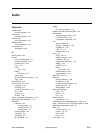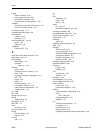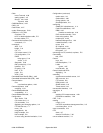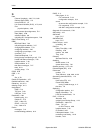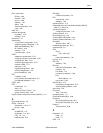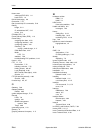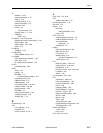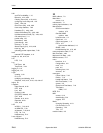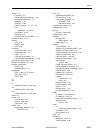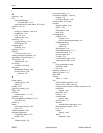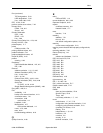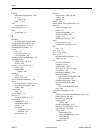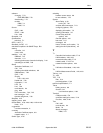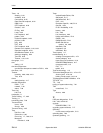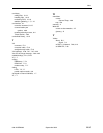
Index
9128-A2-GB20-80 September 2002
IN-11
Port
(continued)
TCP designations, C-33
UDP designations, C-34
Use, 4-38, 4-96, 4-100
PPP, 4-100, 4-102
previous recent cause values, 7-42
Primary Clock
Failed, 7-24, 8-11
Source, 4-31
Primary Destination
DLCI, 4-69
EDLCI, 4-70
Link, 4-69
Primary Frame Relay Link, 4-79, 4-81
Primary Link RIP, 4-80
printed reports, 11-7
printer
COM port cable, E-6
printing certificate report, 9-9
problem indicators, 8-2
product-related documents, xiii
Profile ID (SPID), 4-45
profiles
entering, 4-49
Proprietary
Caller Identification Method, 4-51, 6-5
RIP, 4-80
Protocol
address resolution, 1-2, 1-5, 4-95
Address Resolution (ARP), 5-3
Link, 4-100, 4-102
LMI, 1-2, 4-61
Point-to-Point (PPP), 4-100, 4-102
Routing Information (RIP), 4-80, 4-99
Serial Line
IP (SLIP), 4-100, 4-102
Simple Network Management (SNMP), 4-83
Proxy ARP, 4-95, 5-3
PVC
availability, 1-10
backup over network interface, 4-19
connection status, 7-31
connections, 4-68
total number, 1-6
Loopback, 8-23
Management, 4-77
total number dedicated, 1-6
name, 4-75, 4-89
tests, 8-22
troubleshooting problems, 8-16
Q
quality of service, 4-66
R
ratios
FDR and DDR, 1-10
remote loopbacks, 8-31, 8-33
Repeater Loopback, 8-29
reports
certificate summary, 9-9
Network Health, 11-7
reset
last time, 7-19
resetting
statistics, 7-51
the unit, 8-3
unit default configuration options, 8-4
restoring
current router configuration, 5-16
restoring communication with improperly configured unit,
8-4
retrieving statistics, 7-80
Return (Enter) key, 2-6
revision
software and hardware, 7-3–7-4
RFC 1213 and 1573, B-2
RFC 1315, B-2
RFC 1406, B-2
RFC 1604, B-2
RFC 1659, B-2
RFC 1757, B-2
RFC 2021, B-2
RFC 2128, B-2
RFC 2474, 4-27
RfcCodePoints, 4-25
right arrow key, 2-6
RIP, 1-5, 4-99, 7-49
RJ11 modem connector, E-17
RJ48C network cable, E-15
RLB, 8-29
RMON
alarm and event defaults, B-18
Specific Traps, B-16
Traps, 4-91
user history collection, 1-7, 1-10
router
assist feature, 1-7, 4-7, 7-70
configuration using terminal emulation, 5-16
configuring using terminal emulation, 5-16
controlling CLI access, 6-14
filtering, 5-14
independence, 1-5, 4-21
interfaces, 5-2
overview, 5-2
security, 5-14
terminal emulation, 5-16



